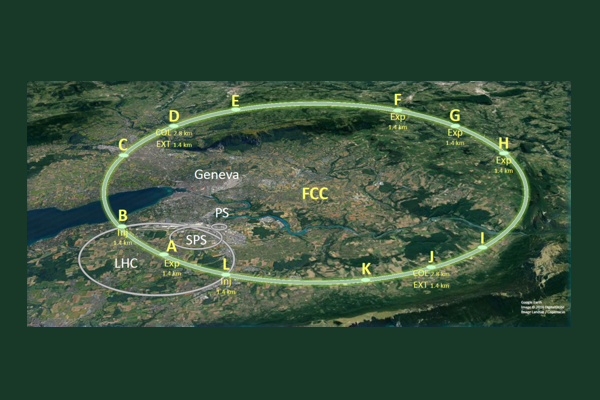It's the universe but not as we know it: Future Circular Collider Week

University of Liverpool to launch a virtual accelerator in FCC Week that anyone can build
Scientists from all over the world will converge on Berlin to discuss the successor to the Large Hadron Collider (LHC). The Future Circular Collider will be three times longer and seven times more powerful and aims to achieve energy levels even closer to those of the ‘Big Bang’. It hopes to find new particles and to prove or disprove our understanding of the rules that govern the universe.
The design of this amazing machine is the focus of the international Future Circular Collider (FCC) Week in Berlin from 29 May - 2 June 2017. The University of Liverpool will be launching a new augmented reality app at FCC Week that will encourage everyone to build their own ‘future accelerator’ using a smartphone and paper cubes.
Professor Carsten P. Welsch Head of Physics at the University of Liverpool comments: “The FCC programme is the world’s biggest experiment. It aims to develop new technologies and also to inspire and encourage the next generation of technologists and scientists. The LHC was created in a collaborative way and the new technologies that emerged as a result include the Internet, proton therapies to treat cancer, new materials and improved ways to preserve food and disinfect drinking water. We anticipate that the FCC will spinout similar advances.”
The LHC found the Higgs boson, a fundamental particle of energy that is profoundly different to all elementary particles discovered so far. Its discovery has opened up new paths for exploration.
Over recent years it has been revealed that things we call particles, such as electrons, are better described as ripples in a field of energy. These fields can be considered fluid and can be compressed and stretched, moving around each other like oil and water – until, that is, they meet the rigid Higgs Field. It is thought that by interacting with the Higgs Field the particles achieve mass and this is how the universe began.
To go further we need a new generation of machines. This will require higher energy to accelerate the particles to greater speeds around a circular track, and powerful magnets to keep the particles together in a tight beam as they gain more speed with each circuit. Once the high-energy beams are created, CERN will smash them together to reveal new particles and develop new techniques to harness their power.
Prof Welsch continues: “Some of these particles will be those predicted by our existing Standard Model of Physics but not yet seen, such as dark matter. We are also curious to see if the experiment will resolve some of the gaps in the Standard Model, for example why there is so little antimatter in the universe. There is also the possibility that the FCC programme will disprove parts of the Standard Model by showing that particles do not have the expected characteristics. As yet we don’t have the knowledge to generate the huge amounts of energy required or to build the super-cooled magnets. At the FCC Conference, during FCC week, discussions will be held about the new designs and what is needed from the international community to develop the technology.”
To help inspire future scientists, supporting the conference will be an exhibition with interactive demonstrations including a walk-through Higgs Field to understand better these challenging ideas, a proton football game to introduce a world of particles, and a simulation that will guide visitors on a journey to the heart of the LHC and provide a glimpse of future plans for larger accelerators that could shape research in the 21st century.
The University of Liverpool will also be launching a new augmented reality app that will allow anyone at home to build their own virtual accelerator and see for themselves how electromagnetic fields can be used to speed up particles.
The exhibition for Future Circular Collider Week is open to visitors and will take place from 30 May – 5 June 2017 at the Urania centre in Berlin.
More details can be found at: fccw2017.web.cern.ch